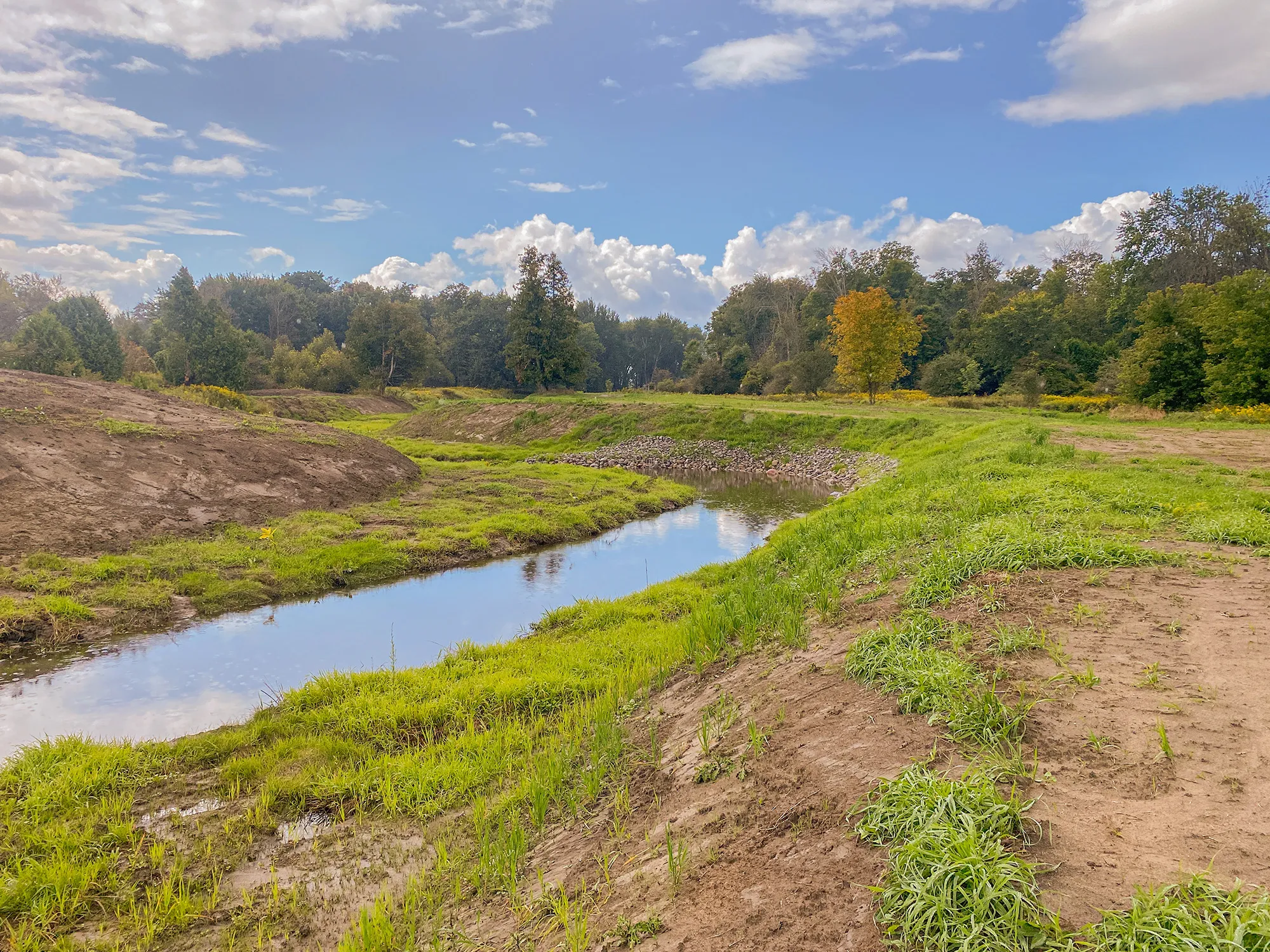Areas of Expertise
Burnside services provided for this project include:
Browse all our services

Drainage Engineering Services
Designing an ecological municipal drainage system that is a Drain Done Differently.
Sector:Municipalities
Town of Innisfil
Innisfil, Ontario
Chris Pfohl, C.E.T., EP, CAN-CISEC

The South Innisfil Creek Drain (SICD) is a Municipal Drain established by the Town of Innisfil (Town) through the authority of a by-law created under the Drainage Act (Act). This project presented several challenges that Burnside saw as opportunities to design an ecological drainage system that can be considered a Drain Done Differently.
Please refer to our Municipal Drainage Services page and the Ontario Government’s Municipal Drains page for more details on Municipal Drains, the Drainage Act, and how they relate to this project.
The SICD was first established in 1903. In the 1950s, several branches were added to the system and improvements were also made to the main drain. The SICD is currently being improved through a Municipal by-law adopting a Report authored by Burnside, a copy of which can be found here.
The SICD (see map) has a contributing watershed of over 80 square kilometres that features about 900 properties and serves lands and roads in the southwest portion of the Town, as well as in the northern portion of Bradford West Gwillimbury. The outlet for the 10 km SICD Main Drain is a natural watercourse known as Innisfil Creek – a 44 km tributary of the Nottawasaga River – which enters the Nottawasaga River near Alliston about 80 km from its final outlet into Nottawasaga Bay at Wasaga Beach. Innisfil Creek is the outlet for almost 150 km of Municipal Drains and has a catchment area of approximately 480 square kilometres.
OSPE Land Drainage Committee
https://opened.uoguelph.ca/drainage
On behalf of R.J. Burnside & Associates Limited and with the generous funding of the Ontario Ministry of Agriculture, Food, and Rural Affairs – OMAFRA – we bring you this story about a “Drain Done Differently,” an innovative drainage project in the Town of Innisfil that is intended to reduce future flooding events and improve drain water quality for its residents and stakeholders.
Ontario has countless municipal drains – constructed under the Drainage Act since the early 1800s – which, simply put, are systems that help improve the drainage of primarily agricultural properties.
The South Innisfil Creek Drain – or SICD – is a municipal drain that has existed since 1903, spanning a length of 10 kilometres and a watershed area of over 80 square kilometres. In all, the SICD helps to collect and convey runoff from about 900 properties, so it is critical that it performs as intended.
In addition, the SICD is a part of the headwaters of the Nottawasaga River, which ultimately flows into Georgian Bay at Wasaga Beach, the longest freshwater beach in the world and a location with Blue Flag ecological status from the Foundation for Environmental Education.
Like any built infrastructure, the SICD’s performance had declined over time, and it was considered one of the most degraded portions of the Nottawasaga River, according to Nottawasaga Valley Conservation Authority (NVCA) staff. As such, it was critical for the SICD to be improved to address not only the quality of water discharged through it, but also the quantity of water that it could handle.
In 2016, Burnside was retained by the Town to complete an Engineer’s Report for a series of improvements to the SICD. Key recommendations from the report included:
Extend the SICD downstream, approximately 500 metres south of Highway 89.
Improve approximately 10 km of the Main Drain for free flow conveyance of a two-year storm event plus freeboard.
Improve the crossings under Hwy. 400 & Reive Blvd.
Improve approximately 4.5 km of four Branch Drains.
Following adoption of this report by Town Council in 2019, Burnside was then retained to tender and complete the construction of the report’s recommendations.”
“The project team understood the unique challenges that the SICD presented, and the team wanted to address these challenges with correspondingly unique and innovative solutions. In short, the SICD would become a Drain Done Differently.The first unique innovation was the construction of a two-stage drain, rather than the usual trapezoidal design common to most municipal drains. The two-stage solution was chosen for its ability to better mimic the structure of a natural channel, as well as its ability to produce faster flow velocities in the low flow portion which improves water quality via reduced sediment deposition and provides better aquatic habitat. Furthermore, a cleaner drain allows for more volume to flow through, requires less drain maintenance for stakeholders and saves costs.
Additionally, a two-stage drain is more stable, thanks to its ability to distribute larger flow events such as spring runoff, storm events and overland flooding over its wider vegetated floodplain bench which acts as a natural filter strip. This bench slows down the flow velocity, allows for sediment deposition out of the low flow portion, and provides nutrients for vegetation growth, shade cover and habitat.
Approximately 20 locations along the SICD benefited from the development of Woody Material Structures, which helped to improve flow conditions, stabilize drain banks, reduce sediment deposition, and provide species habitat.
The structures were built by taking existing woody material that had created flow blockages in the drain, supplementing it with woody material cut and salvaged on-site, adding additional material such as rip rap and sod mats to provide ballast and vegetation coverage, and securing the structures to the drain bank with sharpened wood pieces to act as stakes or pins installed by an excavator. The result is a natural looking bank that is stable, permits undisturbed flow, and is a prime habitat for local species.
One unique innovation was dubbed the “leaky berm,” a perforated organic barrier built to permit water to flow through it to support a backwater habitat refuge.
Organic debris and sediment had built up in a 90-degree bend in the drain, clogging and disrupting the low flow portion. As a result, this blockage had created a backwater area that had become a habitat for several species in the area.
The desire to protect this habitat while restoring proper flow in the SICD gave rise to the ‘leaky berm,’ built with woody materials and sod mats, and anchored in place using long cedar pins placed with an excavator. This solution was innovative in that nothing was sacrificed – species habitat was maintained, and the low flow portion was reinstated to match the pre-improvement condition.
Two other unique drain improvement features were the creation of an offset wetland in an existing oxbow off the main drain, and the stabilization of a severely eroded drain bank while protecting and retaining a bank swallow nesting habitat.
The entire Burnside team would like to thank OMAFRA for funding the promotion of the success of the SICD, as well as the NVCA for their support and collaboration throughout the project.
Special thanks also go out Town Staff and Council, the watershed community stakeholders, and notably R&D Excavating LTD, who did outstanding work in constructing the designed improvements to the drain.
Please visit rjburnside.com for more details on this important green infrastructure project, one that is truly a Drain Done Differently.


We encourage you to contact us if you have any questions or require assistance.